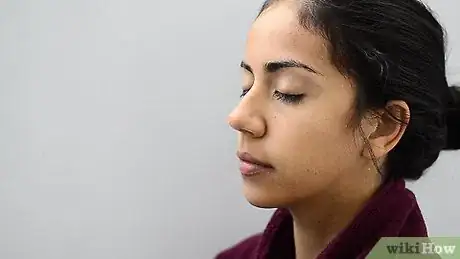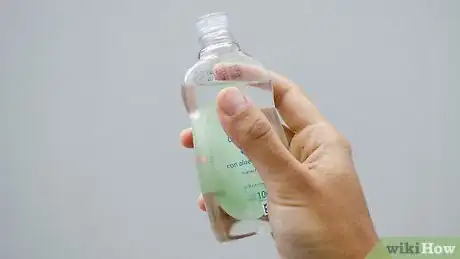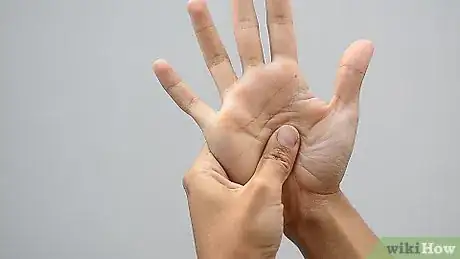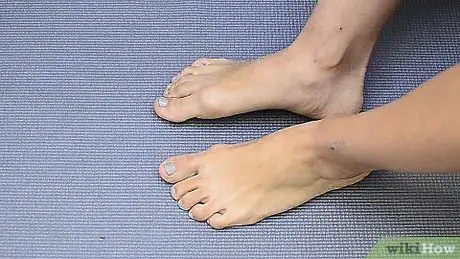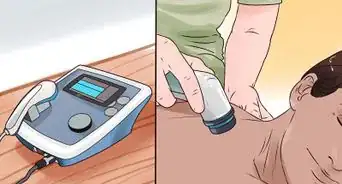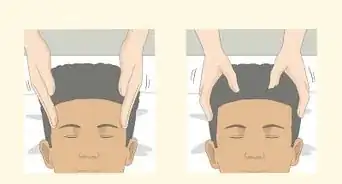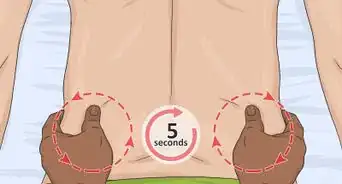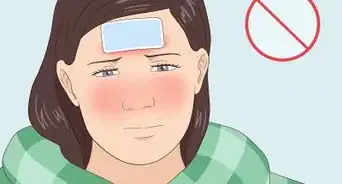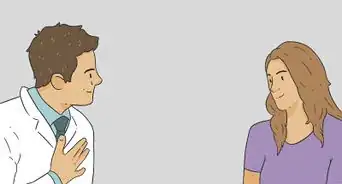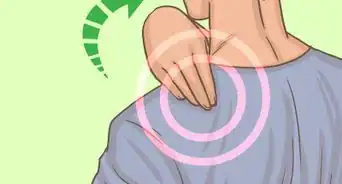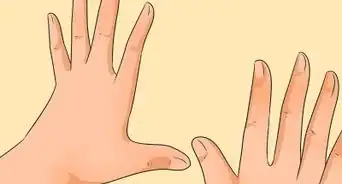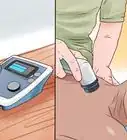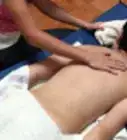This article was co-authored by Will Fuller. Will Fuller is a Certified Massage Therapist and Wellness Educator working in San Francisco, California. Will has worked with the Sports and Recreation Center at the University of California, San Francisco (UCSF), taught sports in England, Kenya, and Kuwait, and is now affiliated with the Chiro-Medical Group. He was trained in physical rehabilitation under a program founded by Dr. Meir Schneider. He has a Bachelors in Sport Science and a Post-Graduate Certificate of Education in Physical Education from Southampton University.
wikiHow marks an article as reader-approved once it receives enough positive feedback. In this case, 100% of readers who voted found the article helpful, earning it our reader-approved status.
This article has been viewed 892,235 times.
Do you feel stiff and sore after you wake up or get home from work? If so, your body may be growing tense and developing uncomfortable knots. Massaging yourself can help reduce these issues by loosening your muscles so you can relax. Ready to wind down and treat yourself? We'll walk you through an easy self-massage routine that'll leave you feeling refreshed and re-energized.
Things You Should Know
- To prepare, take a warm bath or shower and dry off; consider keeping your clothing off (though it’s not mandatory) and apply massage oil.
- Massage your neck and shoulder for headaches, your abdomen for menstrual pain and digestion, your back to relieve tension, and your lower back to loosen sore muscles.
- Massage your arms and legs to relieve stiff muscles, your hands and feet to lessen tension, and your legs to relieve cramped muscles.
Steps
Preparing Your Body for a Massage
-
1Take a warm bath or shower and dry yourself with a warm towel. The warm water will loosen up your muscles and make them ready for a massage. Soaking in some Epsom salt will help to alleviate soreness.
- Place a towel in a dryer while you're taking your bath to warm it up. When you get out of the shower, feel the relief from drying yourself with a nice warm towel.
-
2Consider keeping your clothing off. Skin-to-skin contact is more effective than massaging through clothing. However, if you're using a foam roller to massage yourself, or lack privacy at home, you can put on some light clothes.Advertisement
-
3Apply massage oil to your body. Massage oil will help heat up your body and will help make your massage be more effective. Any massage oil, lotion, or sports balm will help break down knots and loosen your muscles. To apply massage oil, just place a drop of the oil in the palm of one hand and rub your hands together for at least fifteen seconds, until you've heated up the oil.
Massaging Your Upper Body
-
1Massage your neck and shoulders to relieve headaches. Use your left hand to stroke your left shoulder and the left side of your neck, and vice versa. Gently but firmly work your fingers in small circles, starting at the base of your skull and working down towards the shoulders. When you feel a knot, work it out in small circles with your fingers, massaging clockwise and then counter-clockwise. Here are a few more self-massaging techniques to try:
- Place your hands into fists and gently rub your spine in a circular motion.
- Place your fingertips at your ears and gently move them down your jaw until both hands meet up at your chin.
- After you have worked out all the knots, stretch out your shoulder blades by hugging yourself.
-
2Massage your abdomen to help with menstrual pain and digestion issues. Place the surface of one hand on your abdomen and gently stroke it in a circular motion. Then, use the fingers and thumbs of both hands to knead your abdomen. Gently use your fingers to stroke your lower abdomen in circular motions. If you'd like to stroke the sides of your abdomen, just roll over to one side and then the other to have better access to the opposing side.[1]
- While standing, bend your knees to the left while massaging the right side of your abdomen.
- Apply pressure on different parts of your abdomen with your fingers, and release after a few seconds.
-
3Massage your back with a ball to relieve tension. Take a ball of any size, from a tennis ball to a basketball, and press it up against a wall with your back. Move your body back and forth and in circular motions to relieve the pressure from your back. Place the ball on different parts of your back, from your lower to your upper back, to relieve the tension from different parts of your body.[2]
- For added variety, you can alternate between using a larger and smaller ball during the same self-massage session.
-
4Massage your lower back with a foam roller to loosen up sore muscles. You can wear clothes for this. A foam roller will work best, but you can also roll up a large blanket, towel, or yoga mat in a pinch. Place the roller on the floor and lay face up on the roller. Position your lower back over the roller so that your shoulders and butt are touching the floor and you're perpendicular to the roller.
- Use your feet to help you move up and down the roller slowly, feeling the roller move up and down each of your vertebrae.
- Gently roll up or down the roller until you find a trigger point or a painful area. Then, stay rolled over the area for at least 30 seconds. This will hurt a bit, but it will relieve the tension from the area afterwards.
- To target smaller areas of your back, use a rolling pin instead of a blanket.
Massaging Your Arms and Legs
-
1Massage your arms to relax any tense, stiff muscles. To massage your arms, start by making long flowing strokes with the opposite hand all the way up your arm, from your wrists to your shoulder. Continue to make these long strokes until you feel your arms heating up. Then, transition to making smaller little circles all over your forearms and upper-arms.
- Switch back and forth between the long-flowing strokes and the smaller circles until your arms feel heated and relaxed.
-
2Massage your hands to alleviate tension or pain. Gently squeeze one hand by pressing it between the palm and fingers of your other hand. Then, squeeze each finger and run the thumb from your other hand along the joints of the fingers in a circular motion. Hold the finger at its base and gently pull it up so that you're stretching the fingers upwards. Use your thumb to stroke the tendons on the back of the hands.[3]
- Use your thumb to put pressure on your palms and wrists, moving it in a circular motion.
- To complete the massage, stroke your palm gently from your fingers to your wrist. If you're using oil, rub your hands together to massage the oil further into your hands. You can also complete this motion even if you're not using oil.
-
3Massage your legs to relieve soreness and cramped muscles. Glide your fingers over your legs, starting at your feet and working all the way up to your waist. Glide your fingers over your calves, shins, quads, and hamstrings. Start with light motions and then dig in with your palm, moving in firmer circles. You can start squeezing your muscles with one of your hands, massaging them with your fists, or even pressing into them with your elbow.[4]
- Try the drumming technique. Use the side of your hand to make a gentle chop all the way up your leg. This can help ease cramped muscles and relieve soreness.
-
4Massage your feet to release built-up tension. To massage your feet, dig your thumbs in a circular motion into the soles of your feet and the bottoms of your toes. You can also start at your ankle and rub your thumbs outwards across the top of your feet and down the toes. You can support your foot with one hand while working on each toe with the other hand. Squeeze each toe and gently pull it upward. Place your thumb on each of the joints on your toes and move it in a circular motion.
- Massage the soles of your feet either by creating circular motions with both of your thumbs, or putting your hand into a fist and running it up and down the soles of your feet.
- Use your fingertips to stroke your ankle up and down.
- Squeeze your Achilles tendon several times.
- Finish the massage by gently stroking your foot.
Expert Q&A
Did you know you can get expert answers for this article?
Unlock expert answers by supporting wikiHow
-
QuestionHow do you give yourself a neck massage?
 Jason Myerson, DPT, DMT, OCS, FAAOMPTJason Myerson is a Physical Therapist and a Certified Orthopedic Specialist. He is affiliated with Performance Physical Therapy & Wellness with clinics located in Connecticut. He serves as adjunct faculty in the Physical Therapy Department at Quinnipiac University. Jason specializes in helping active people get back to hobbies, activities, and sports they love while utilizing an integrated approach to wellness. He holds an MA in Physical Therapy from Quinnipiac University and a Doctorate in Physical Therapy (DPT) from Arcadia University. He is Residency and Fellowship trained in Orthopedic Manual Therapy, achieved a Doctorate in Manual Therapy (DMT) and became a Fellow of the American Academy of Orthopedic Manual Physical Therapists (FAAOMPT).
Jason Myerson, DPT, DMT, OCS, FAAOMPTJason Myerson is a Physical Therapist and a Certified Orthopedic Specialist. He is affiliated with Performance Physical Therapy & Wellness with clinics located in Connecticut. He serves as adjunct faculty in the Physical Therapy Department at Quinnipiac University. Jason specializes in helping active people get back to hobbies, activities, and sports they love while utilizing an integrated approach to wellness. He holds an MA in Physical Therapy from Quinnipiac University and a Doctorate in Physical Therapy (DPT) from Arcadia University. He is Residency and Fellowship trained in Orthopedic Manual Therapy, achieved a Doctorate in Manual Therapy (DMT) and became a Fellow of the American Academy of Orthopedic Manual Physical Therapists (FAAOMPT).
Physical Therapist & Certified Orthopedic Specialist Physical Therapist & Certified Orthopedic SpecialistExpert AnswerIf you're experiencing soreness in your neck, take a hot shower or apply a hot pack to the area, and gently massage the area. In addition, you can try some gentle range-of motion stretches and arm movements to help improve the blood flow to the area, which could help. Just make sure that when you're stretching your neck, you always do so lightly, or you could hurt more later.
Physical Therapist & Certified Orthopedic SpecialistExpert AnswerIf you're experiencing soreness in your neck, take a hot shower or apply a hot pack to the area, and gently massage the area. In addition, you can try some gentle range-of motion stretches and arm movements to help improve the blood flow to the area, which could help. Just make sure that when you're stretching your neck, you always do so lightly, or you could hurt more later. -
QuestionWhy doesn't it feel good when you massage yourself?
 Will FullerWill Fuller is a Certified Massage Therapist and Wellness Educator working in San Francisco, California. Will has worked with the Sports and Recreation Center at the University of California, San Francisco (UCSF), taught sports in England, Kenya, and Kuwait, and is now affiliated with the Chiro-Medical Group. He was trained in physical rehabilitation under a program founded by Dr. Meir Schneider. He has a Bachelors in Sport Science and a Post-Graduate Certificate of Education in Physical Education from Southampton University.
Will FullerWill Fuller is a Certified Massage Therapist and Wellness Educator working in San Francisco, California. Will has worked with the Sports and Recreation Center at the University of California, San Francisco (UCSF), taught sports in England, Kenya, and Kuwait, and is now affiliated with the Chiro-Medical Group. He was trained in physical rehabilitation under a program founded by Dr. Meir Schneider. He has a Bachelors in Sport Science and a Post-Graduate Certificate of Education in Physical Education from Southampton University.
Certified Massage Therapist Honestly, a professional massage therapist is going to know all of the tricks and maneuvers when it comes to actually relieving tension. They're also going to see and feel problems with your body that you probably aren't going to be able to identify. You can massage yourself, but go see a pro if you want a really good massage.
Honestly, a professional massage therapist is going to know all of the tricks and maneuvers when it comes to actually relieving tension. They're also going to see and feel problems with your body that you probably aren't going to be able to identify. You can massage yourself, but go see a pro if you want a really good massage. -
QuestionWhy do I always tense back up a few days after massaging myself?
 Will FullerWill Fuller is a Certified Massage Therapist and Wellness Educator working in San Francisco, California. Will has worked with the Sports and Recreation Center at the University of California, San Francisco (UCSF), taught sports in England, Kenya, and Kuwait, and is now affiliated with the Chiro-Medical Group. He was trained in physical rehabilitation under a program founded by Dr. Meir Schneider. He has a Bachelors in Sport Science and a Post-Graduate Certificate of Education in Physical Education from Southampton University.
Will FullerWill Fuller is a Certified Massage Therapist and Wellness Educator working in San Francisco, California. Will has worked with the Sports and Recreation Center at the University of California, San Francisco (UCSF), taught sports in England, Kenya, and Kuwait, and is now affiliated with the Chiro-Medical Group. He was trained in physical rehabilitation under a program founded by Dr. Meir Schneider. He has a Bachelors in Sport Science and a Post-Graduate Certificate of Education in Physical Education from Southampton University.
Certified Massage Therapist
References
- ↑ http://www.dailymail.co.uk/health/article-104008/How-massage-stomach.html
- ↑ Will Fuller. Certified Massage Therapist. Expert Interview. 9 January 2020.
- ↑ http://www.rd.com/health/wellness/learn-the-art-of-self-massage/
- ↑ http://www.runnersworld.com/health/self-massage-techniques
- Videos provided by Banyan Botanicals
About This Article
To get ready for a massage, take a warm shower to loosen up your muscles. Dry yourself with a warm towel, then apply massage oil to the areas you want to target. To loosen up your neck and shoulders, rub your skin using small circular motions, focusing on areas where you feel knots. If you’re dealing with stomach or menstrual pain, knead your abdomen in large circular motions. To target your back, hold a ball between your back and the wall, then move your body up and down, rolling the ball. For tips on massaging your arms and legs, read on!
